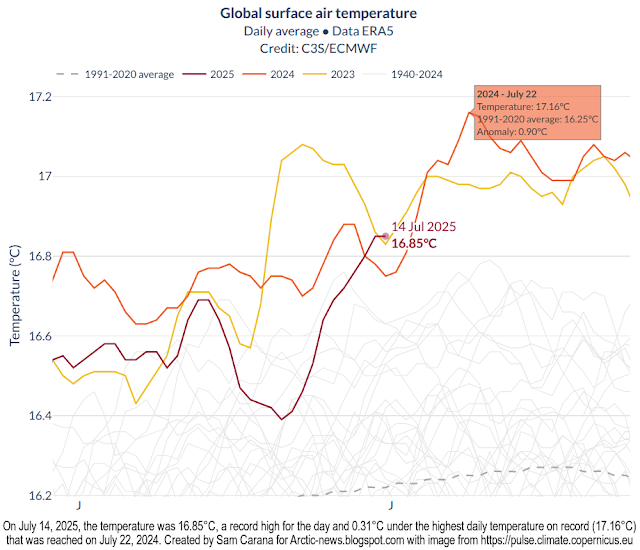The image below shows that the Arctic sea ice extent was at a record daily low on December 2, 2025.

Loss of sea ice extent means that less sunlight gets reflected back into space and instead gets absorbed by the sea surface, resulting in higher temperatures, in a self-amplifying feedback loop.
The image on the right shows Arctic snow cover and sea ice concentration on December 2, 2025.
Furthermore, loss of Arctic sea ice volume can contribute to a huge rise in temperature as a result of methane erupting from the seafloor of the Arctic Ocean. As Arctic sea ice shrinks in volume, its capacity shrinks to act as a buffer that consumes ocean heat entering the Arctic Ocean from the Atlantic Ocean. As the buffer disappears, the temperature of the water can rise strongly and abruptly, causing heat to penetrate sediments that contain huge amounts of methane in the form of hydrates and free gas underneath hydrates. Heat penetrating such sediments can destabilize such hydrates, resulting in huge eruptions of methane.
Such an event could be triggered by wild weather swings resulting from higher temperatures that come with the next El Niño that may emerge and strengthen in the course of the year 2026.
Global sea ice
The image below shows that global sea ice extent was second lowest on record for the time of year on December 2, 2025, a deviation from 1981-2010 of -5.28σ.
 |
| [ click on images to enlarge ] |
The image on the right shows Antarctic snow cover and sea ice concentration on December 2, 2025, by ClimateReanalyzer.
An Antarctic Blue Ocean Event (sea ice approaching a low of one million km²) threatens to occur in February 2026, with the danger that this will in turn trigger an Arctic Blue Ocean Event later in 2026.
The combination image below shows the Antarctic sea ice concentration (left) and thickness (right) thickness on December 1, 2025, by the University of Bremen.
The next El Niño
 |
| [ click on images to enlarge ] |
Methane
The methane danger is discussed in many earlier posts such as this one and is further illustrated by the image below that shows hourly average in situ methane measurements well above 2400 ppb (parts per billion). The image is adapted from an image issued by NOAA December 1, 2025. The image shows methane recorded over the past few years at the Barrow Atmospheric Baseline Observatory (BRW), a NOAA facility located near Utqiaġvik (formerly Barrow), Alaska, at 71.32 degrees North latitude.

Temperature rise
The image below with NASA Land Only temperature anomalies with respect to 1880-1980 (not pre-industrial) shows that the 1.5°C threshold has been crossed for all months since 2022 (black squares) through October 2025. The LOWESS 3-year smoothing trend (red line) indicates that the 2°C threshold was crossed in 2022 and that 3°C may get crossed early 2029 if this trend continues (dashed extension).

Using land-only anomalies is important, since most people do live on land. The 3°C threshold is important since humans are likely to go extinct with a 3°C rise, as discussed in an earlier post. The 1880-1890 base is not pre-industrial, when using a genuinely pre-industrial base, temperature anomalies are likely to be higher.
Climate Emergency Declaration
UN secretary-general António Guterres recently spoke about the need for “a credible global response plan to get us on track” regarding the international goal of limiting the global temperature rise. “The science demands action, the law commands it,” Guterres said, in reference to a recent international court of justice ruling. “The economics compel it and people are calling for it.”
What could be added is that the situation is dire and unacceptably dangerous, and the precautionary principle necessitates rapid, comprehensive and effective action to reduce the damage and to improve the outlook, where needed in combination with a Climate Emergency Declaration, as described in posts such as this 2022 post and this one and as discussed in the Climate Plan group.
• NOAA - National Centers for Environmental Prediction
• The danger of abrupt eruptions of seafloor methane
• NOAA - Global Monitoring Laboratory - Data Visualisation - flask and station methane measurements
https://gml.noaa.gov/dv/iadv
• NASA - GISS Surface Temperature Analysis - custom plots
• When Will We Die?
https://arctic-news.blogspot.com/2019/06/when-will-we-die.html
• Pre-industrial
https://arctic-news.blogspot.com/p/pre-industrial.html
• Transforming Society
https://arctic-news.blogspot.com/2022/10/transforming-society.html
• Climate Plan
https://arctic-news.blogspot.com/p/climateplan.html
• Climate Emergency Declaration
https://arctic-news.blogspot.com/p/climate-emergency-declaration.html

























































